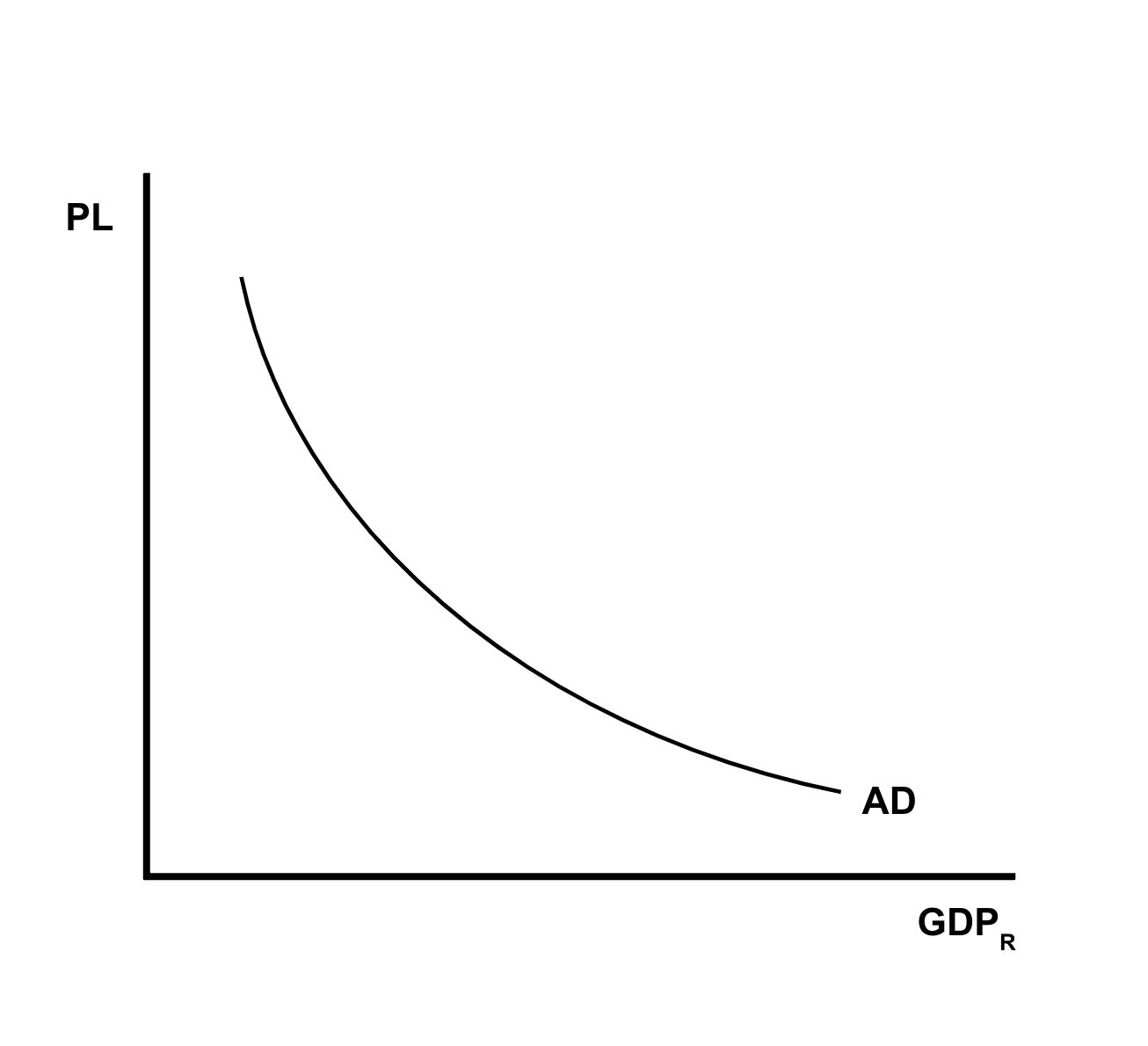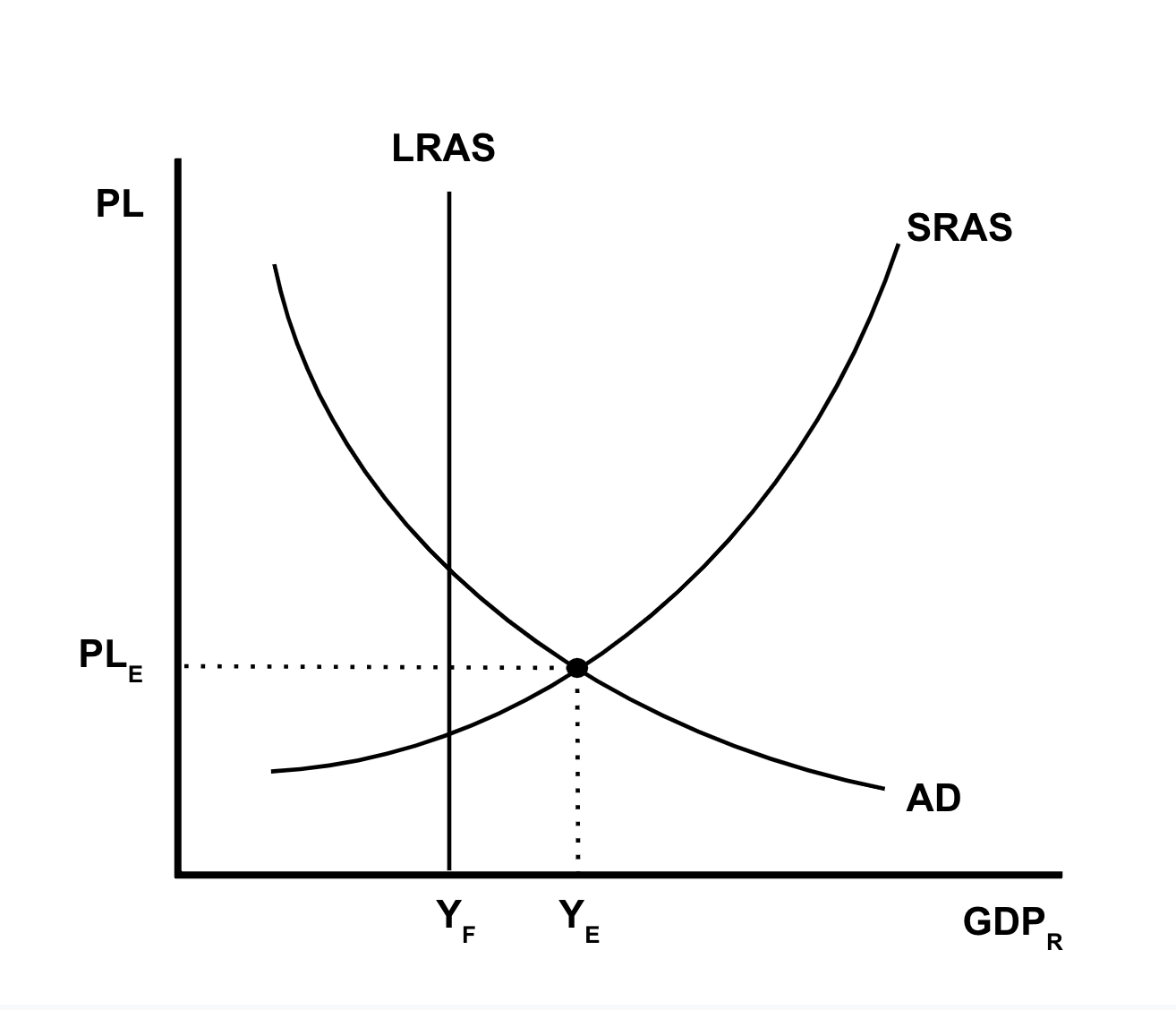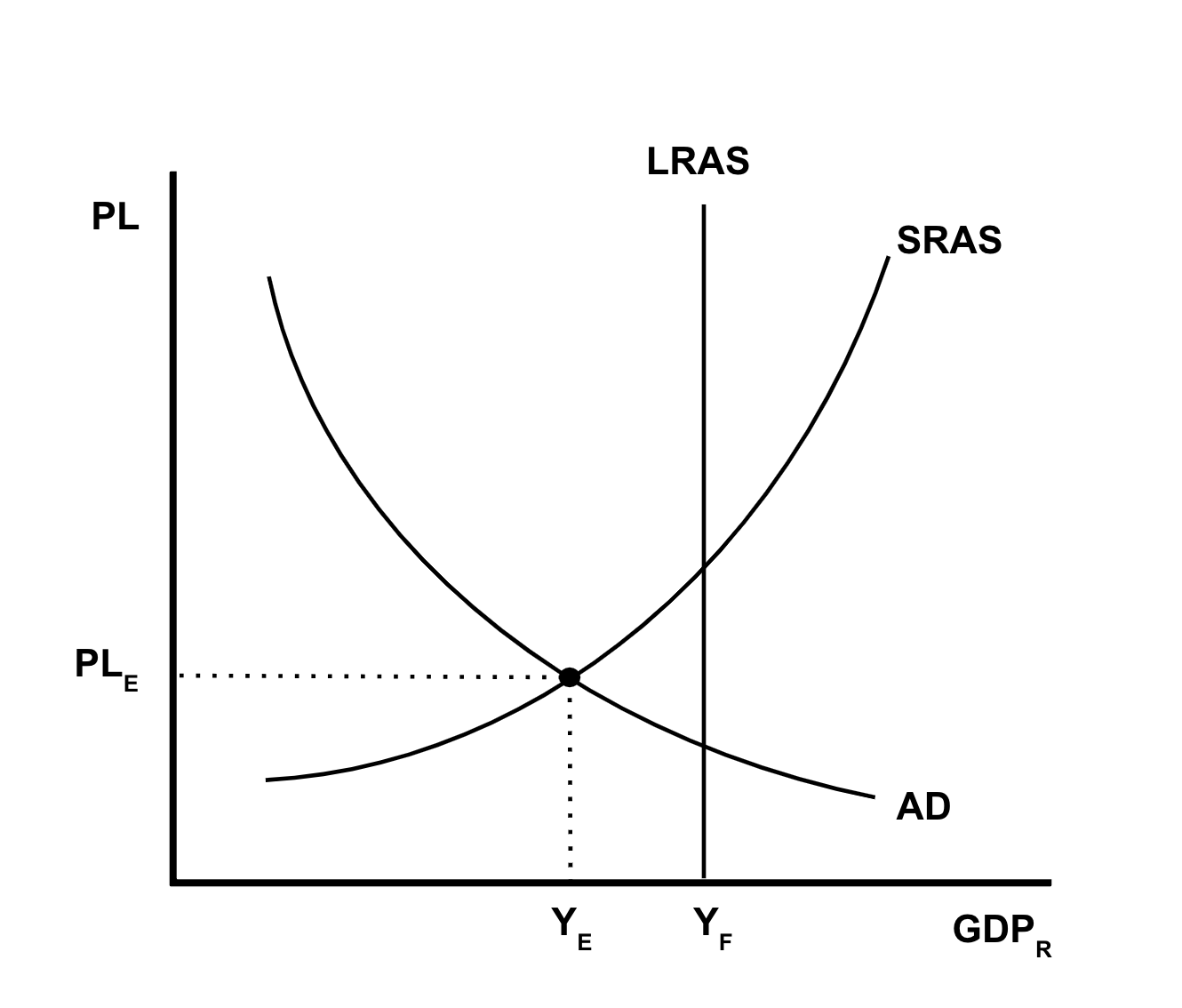AP Macro Unit 3
5.0(2)
5.0(2)
Card Sorting
1/45
Earn XP
Description and Tags
Study Analytics
Name | Mastery | Learn | Test | Matching | Spaced |
|---|
No study sessions yet.
46 Terms
1
New cards
Aggregate Demand
all the goods and services (real GDP) that buyers are willing and able to purchase at different price levels
2
New cards
Aggregate Demand Curve
→ the demand by consumers, businesses, government, and foreign countries
→ downward slope
→ x-axis: real domestic output, y-axis: price level
→ downward slope
→ x-axis: real domestic output, y-axis: price level

3
New cards
Wealth Effect
→ higher price levels reduce the purchasing power of money; this decreases the quantity of expenditures
→ lower price levels increase the purchasing power and increase expenditures
→ Real Balance Effect
→ lower price levels increase the purchasing power and increase expenditures
→ Real Balance Effect
4
New cards
Interest Rate Effect
→ when the price level increases, lenders need to charge higher interest rates to get a REAL return on their loans
→ higher interest rates discourage consumer spending and business investment
→ higher interest rates discourage consumer spending and business investment
5
New cards
Foreign Trade Effect
→ when U.S. price level rises, foreign buyers purchase fewer U.S. goods and Americans buy more foreign goods
→ exports fall and imports rise causing real GDP demanded to fall
→ exports fall and imports rise causing real GDP demanded to fall
6
New cards
Shifters of Aggregate Demand
( 1 ) Change in Consumer Spending
( 2 ) Change in Investment Spending
( 3 ) Change in Government Spending
( 4 ) Change in Net Exports (X - M)
( 2 ) Change in Investment Spending
( 3 ) Change in Government Spending
( 4 ) Change in Net Exports (X - M)
7
New cards
Change in Consumer Spending
→ increase in disposable income
→ consumer expectations
→ household indebtedness
→ taxes
→ consumer expectations
→ household indebtedness
→ taxes
8
New cards
Change in Investment Spending
→ real interest rates (price of borrowing money)
→ future business expectations
→ business taxes
→ future business expectations
→ business taxes
9
New cards
Change in Government Spending
→ government expenditures
10
New cards
Change in Net Exports
→ exchange rates
→ national income compared to abroad
→ national income compared to abroad
11
New cards
Marginal Propensity to Consume (MPC)
how much people consume rather than save when there is a change in disposable income (always expressed as a decimal)
MPC = Change in Consumption / Change in Disposable Income
MPC = Change in Consumption / Change in Disposable Income
12
New cards
Marginal Propensity to Save (MPS)
how much people save rather than consume when there is a change in disposable income (always expressed as a decimal)
MPS = Change in Save / Change in Disposable Income
MPS = Change in Save / Change in Disposable Income
13
New cards
Calculating the MPS
1 / MPS or 1 / 1 -- MPC
14
New cards
Total Change in GDP
Total Change in GDP = Multiplier * Initial Change in Spending
15
New cards
Calculating the Tax Multiplier
MPC / MPS
The Tax Multiplier is always one less than the Spending Multiplier
The Tax Multiplier is always one less than the Spending Multiplier
16
New cards
MPS = 1 -- MPC
people can either save or consume
17
New cards
Total Change in GDP (w/Tax Multiplier)
Total Change in GDP = Tax Multiplier * Initial Change in Taxes
18
New cards
Aggregate Supply
the amount of goods and services (Real GDP) that firms will produce in an economy at different price levels, the supply for everything by all firms
19
New cards
Short-run Aggregate Supply (SRAS)
wages and resource prices are sticky and WILL NOT change as price levels change
20
New cards
Long-run Aggregate Supply (LRAS)
wages and resource prices are flexible and WILL change as price levels change
21
New cards
Shifters of Short-run Aggregate Supply
( 1 ) Change in Resource Prices
( 2 ) Change in Actions of the Government (NOT Government Spending)
( 3 ) Change in Productivity
( 2 ) Change in Actions of the Government (NOT Government Spending)
( 3 ) Change in Productivity
22
New cards
Shifter of SRAS: Change in Resource Prices
→ price of domestic and imported resources
→ supply shocks
→ inflationary expectations
→ supply shocks
→ inflationary expectations
23
New cards
Supply Shock
an unexpected event that suddenly changes the supply of a commodity resulting in an unforeseen change in price
→ negative supply shock: low supply, high price
→ positive supply shock: increased supply, low price
→ negative supply shock: low supply, high price
→ positive supply shock: increased supply, low price
24
New cards
Shifter of SRAS: Change in Actions of the Government
→ taxes on producers
→ subsidies for domestic producers
→ government regulations
→ subsidies for domestic producers
→ government regulations
25
New cards
Shifter of SRAS: Change in Productivity
→ technology
26
New cards
Shifters of Long-run Aggregate Supply
( 1 ) Change in Resource Quantity or Quality
( 2 ) Change in Technology
( 3 ) Change in Population
(SAME SHIFTERS AS THE PPC!!!!)
( 2 ) Change in Technology
( 3 ) Change in Population
(SAME SHIFTERS AS THE PPC!!!!)
27
New cards
Difference Between SRAS and LRAS
SRAS → in the short run, wages and resource prices are sticky and WILL NOT change when price level changes
LRAS → in the long run, wages and resource prices are flexible and WILL change when price level changes
LRAS → in the long run, wages and resource prices are flexible and WILL change when price level changes
28
New cards
AD/AS Equilibrium: Full Employment
Long Run Equilibrium
the economy is at potential output
the economy is at potential output
29
New cards
AD/AS Equilibrium: Inflationary Gap
ABOVE or BEYOND full employment, positive output gap

30
New cards
AD/AS Equilibrium: Recessionary Gap
BELOW or LESS THAN full employment, negative output gap

31
New cards
Stagflation
stagnant economy + inflation
SRAS decreases, causing high unemployment and high inflation
SRAS decreases, causing high unemployment and high inflation
32
New cards
Disposable Income
the amount of money households have to save or spend after taxes
33
New cards
(Supply) Cost-Push Inflation
(SRAS decrease)
→ tighter production costs increase prices
→ a negative supply shock increases the costs of production and forces producers to increase prices
→ tighter production costs increase prices
→ a negative supply shock increases the costs of production and forces producers to increase prices
34
New cards
(Demand) Demand-Pull Inflation
(AD increase)
→ demand pulls up prices: consumers want goods and services so bad they pull up prices
→ "too many dollars chasing too few goods"
→ demand pulls up prices: consumers want goods and services so bad they pull up prices
→ "too many dollars chasing too few goods"
35
New cards
Role of Consumers in the Economy
→ consumers will spend a certain amount no matter what, regardless of their income (this is usually called autonomous consumption)
→ consumer spending is made up of autonomous spending and disposable income
→ if incomes are less than autonomous spending, then there is dissaving (or negative savings)
→ consumer spending is made up of autonomous spending and disposable income
→ if incomes are less than autonomous spending, then there is dissaving (or negative savings)
36
New cards
How Does the Government Stabilize the Economy?
( 1 ) Fiscal Policy → actions by Congress to stabilize the economy
( 2 ) Monetary Policy → actions by the Federal Reserve Bank to stabilize the economy
( 2 ) Monetary Policy → actions by the Federal Reserve Bank to stabilize the economy
37
New cards
Discretionary Fiscal Policy
Congress creates a new bill that is designed to change AD through government spending or taxation
→ one problem is lag times due to bureaucracy
→ it takes time for Congress to act
→ EX.) in a recession, Congress increases spending
→ one problem is lag times due to bureaucracy
→ it takes time for Congress to act
→ EX.) in a recession, Congress increases spending
38
New cards
Non-Discretionary Fiscal Policy
(AKA: Automatic Stabilizers)
Permanent spending or taxation laws enacted to work counter-cyclically to stabilize the economy
→ when GDP goes down, government spending automatically increases, and taxes automatically fall
→ EX.) Welfare, Unemployment, Income Tax
Permanent spending or taxation laws enacted to work counter-cyclically to stabilize the economy
→ when GDP goes down, government spending automatically increases, and taxes automatically fall
→ EX.) Welfare, Unemployment, Income Tax
39
New cards
Contraction Fiscal Policy (The BRAKE)
Laws that reduce inflation, decrease GDP (close an Inflationary Gap)
→ decrease government spending
→ increase taxes (decrease disposable income)
→ combinations of the two
→ decrease government spending
→ increase taxes (decrease disposable income)
→ combinations of the two
40
New cards
Expansionary Fiscal Policy (The GAS)
Laws that reduce unemployment and increase GDP (close recessionary gap)
→ increase government spending
→ decrease taxes (increasing disposable income)
→ combinations of the two
→ increase government spending
→ decrease taxes (increasing disposable income)
→ combinations of the two
41
New cards
Timing and Fiscal Policy
Fiscal Policy has three time lags:
( 1 ) Recognition Lag → Congress must react to economic indicators before it's too late
( 2 ) Administrative Lag → Congress takes time to pass legislation
( 3 ) Operational Lag → spending/planning takes time to organize and execute (changing taxing is quicker)
( 1 ) Recognition Lag → Congress must react to economic indicators before it's too late
( 2 ) Administrative Lag → Congress takes time to pass legislation
( 3 ) Operational Lag → spending/planning takes time to organize and execute (changing taxing is quicker)
42
New cards
The Multiplier Effect
the idea that an initial change in spending will set off a spending chain that is magnified in the economy; the strength of the multiplier depends on the amount that consumers spend of new income
43
New cards
Autonomous Consumption
the minimum amount of consumer spending when people have no income
44
New cards
LRAS Self-Adjustment: Positive Output Gap
SRAS will shift left due to an increase in expected inflation, which causes wages to increase
45
New cards
LRAS Self-Adjustment: Negative Output Gap
SRAS will shift to the right due to a decrease in wages and resource prices, which causes production costs to fall
46
New cards
Automatic Stabilizers
policies that are already in place in an economy due to previously passed legislation